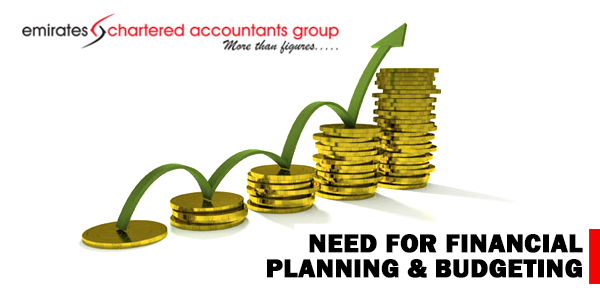
Financial Planning and Analysis
A pilot would never fly a plane from Los Angeles to San Francisco without a flight plan that explains how to get there. Yet all too often, small business people open their doors without clear plans to help them get where they want to go. One of the easiest ways to get there — wherever that is — is by creating a budget and sales forecast. You can seek advice for some of the financial auditors in UAE.
A budget doesn't have to be a restrictive plan that forces you to deprive yourself of what you want. In fact, a budget should be a guide, not a constraint. A reasonable budget allows you to do what you want. It allows you to use your resources where they're most needed, so your business will head in the right direction. Creating a financial plan lets you control your business's cash flow instead of it controlling you.
Financial planning includes:
- Determination of the amount of finance needed by an organization to carry out its operation smoothly.
- Determination of sources of funds.
- Determination of suitable policies for proper utilization and administration of funds.
Importance of Financial planning:
- It facilitates the collection of optimum funds
- It helps in fixing the most appropriate capital structure.
- Helps in Investing Finance in the right projects.
- Helps in operational activities
- The base for financial control.
- Helps in proper utilization of Finance.
- Helps in the coordination of various business functions.
- It helps in deciding Debt/Equity participation.
Budgeting:
The budget is developed in advance of the period that covers and it is based on forecasts and assumptions. It is intended as a planning tool and a guideline to follow in order to achieve the company’s planned goals and objectives.
Creating a budget doesn't have to be a complicated or time-consuming task. Actually, in the beginning, it's best to keep things simple. The key is to determine how much you'll spend and earn in any given year, and then use that figure to project how you want to grow in subsequent years.
If you already own a business, it's simply a matter of digging through some records to see where the money went and deciding where you actually want it to go. Although past financial results and information may be used in developing the budget for the next period, the budget is still documented expression of what the company would like to accomplish financially in future periods. If you're a new entrepreneur, you'll need to do some homework, like getting details of how much your competitor is making and then make some realistic assumptions about your business.
Either way, a budget is simply a tool that allows you to put your money where it can best be used. To get started, answer the following questions:
- How much can you realistically sell next year?
- How much will you charge for your goods or services?
- How much will it cost to produce your product?
- How much are your operating expenses?
- Do you need to hire employees? If so, how many, and how much will you pay them?
- How much will you pay yourself?
- How much payroll tax and unemployment tax will you pay?
- How much money do you need to borrow, and how much will your monthly loan payments be?
It is important that you review the budget at regular intervals and change it when the assumptions on the basis of which budget was made initially have changed. Review and making changes in budget shall ensure that it is always realistic.
Advantages of Budgeting:
- Comprehensive budgeting processes ensure that strategy effectively translates into action if budget is linked to strategy.
- Effective budgeting, processes provide ways to continuously update operational plans to adapt to changing conditions.
- Effective budgeting, promotes the efficient allocation os organizational resources.
- Budgeting aligns incentives for optimal performance.
- Comparing the actual financial performance with the budgeted figures helps to understand the cause and effect relationship among various factors which drive the business and hence corrected action required to be taken to achieve budgets.
Characteristics of successful Budgeting:
- The budget must start with the company’s short – and long-term plans.
- The budget must have the support of the management at all levels.
- The budget should be a motivating device.
- The budget should be flexible.
- The budget should be an accurate representation of what is expected to occur.
- A budget should coordinated between the departments.
Best practice guidelines for the budget process:
- The development of the budget should be linked to corporate strategy.
- Communication is vital.
- Design procedures to allocate funding resources strategically.
- Managers should be evaluated on performance measures other than meeting budget targets.
- Link cost management efforts to budgeting.
- The strategic use of variance analysis.
- Reduce budget complexity and budget cycle time.
- Develop budgets that can be revised if necessary.
- Review the budget on a regular basis throughout the year.
The Operating budget consists of all of the individual operating budgets, such as the sales or revenue budget, the production budget, the purchasing budget, the marketing budget and the research and development budget.
The Financial budget includes the Budgeted Balance sheet, the budgeted statement of Cash Flows, the cash budget and the capital budget.
Steps involved in Operating and Financial Budgets:
- Sales Budget
- Production Budget
- Direct Labour Budget.
- Cost of Goods sold Budget.
- Research and Development Budget.
- Selling & Marketing Budget.
- Administrative and General Expenses Budget.
- Budgets for other expenses or sources of revenue
- Capital Budget – for long term capital expenditures.
- Cash Budget.
Role of Technology in making a budget:
Technology can also play a very important role in reducing the cycle time required to make the budget. Technology must be used to integrate the data and bring it at one place so that must time is not wasted in data sourcing and data collection and more time is invested in data analysis for making the budgets.
MAKING BUDGET UNDER VOLATILE CONDITION:
Most companies find budgeting a formidable challenge even under stable conditions. Managers often spend significant amounts of time on it, only to be dismayed by how little value comes from four to six months’ effort. Under volatile conditions, when economic forecasts change from week to week, developing one reliable budget to coordinate business units and track performance for an entire fiscal year is very difficult.
Following the traditional budget process may even be unproductive. There’s no easy fix, particularly for very large corporations, and companies that have tried to solve the problem don’t have much of a track record. Executives can, however, take several measures to make the process more effective: for instance, scenario planning, zero-based budgeting, and rolling forecasts Let us examine each of this in more detailed.
Scenario Planning:
In more stable times, the budget process is typically an exercise in consensus building—a lengthy and difficult effort to generate a single view of the future to guide a company’s investments and rewards over the coming year. While many management teams speculate informally on how their businesses will evolve, few actively debate a number of scenarios or undertake the concrete short- and long-term financial analyses that would make such a debate meaningful. The process therefore isn’t agile enough to respond to sudden, dramatic changes in the economy.
Any revisions to the budget as the year unfolds are reactive and backward focused rather than reflecting an informed view of alternative future scenarios. Executives at some forward-thinking companies, however, have not only formally developed concrete macroeconomic and business scenarios, including some considered extreme,one but also modelled the implications of each scenario for their own businesses and customers, as well as for competitors.
At the end of the process, these companies adopted a single budget, but they supplemented it with concrete alternative financial statements and business plans based on plausible future scenarios. This approach lets companies build flexibility into their cost structures—for instance, through the outsourcing of services or the use of contingent purchasing contracts—so they can more easily shift from the primary budget if necessary.
ZERO Based Budgeting:
Amid today’s extreme uncertainty, most companies are cutting discretionary expenditures. The typical budget process is not, however, designed to make managers rethink their business models if the recession persists or shifts the economy in a fundamental way. On the contrary, many current budgets are anchored in past ones, with incremental changes to adjust for inflation or specific product trends. Zero-based budgeting was developed during the inflationary environment of the mid-1970s to avoid precisely this trap.2
It starts the process wholly from scratch, assuming different end points for different industries and businesses, such as a 30 percent smaller overall market or a modified organization or portfolio. Operating and capital expenditures are then prioritized according to their alignment with the company’s strategy and their expected returns on investment. Breaking down the budget into such discrete funding decisions makes it easier for the CFO and other senior executives to choose among competing claims on scarce resources.
Rolling forecast:
Most companies prepare informal earnings forecasts on a monthly or quarterly basis, usually in a planning group within the finance department. These forecasts, seldom tied to active decisions about the budget’s management, almost always involve nothing more than updated projections of year-end values. As a result, the company-wide process is opaque, no one is accountable for the outcome, and projections for the rest of the year are less and less valuable as it progresses.
The finance department, trying to explain the actual numbers and to propose ways of closing the gaps, finds itself caught between the CEO and the chief operating officer (COO) on the one hand and the heads of business units on the other.
By the time the business units acknowledged that they would miss their targets, it was too late to take compensatory action. Some leading companies have formalized a process that involves rolling 12- to 18-month forecasts for the most important financial variables. This approach increases the visibility of the process and accountability for it so that CFOs can act when forecasts start to diverge from actual performance.
In companies we’ve observed, the CFO manages the process, convening business leaders, the CEO, and the COO each month or quarter to identify gaps and discuss how to close them. Typically, a good, hard debate among business units examines their performance and generates a way forward.
For companies that aren’t accustomed to this kind of collaboration on their budgets, it represents a big cultural change: managers are accountable for their promises and must collectively adapt to the fast-changing macroeconomic climate.
It is important that the entire operational team is also involved in making and achieving the budget for its success.
Contact
CA Navneeth
Email:nav@emiratesca.com





